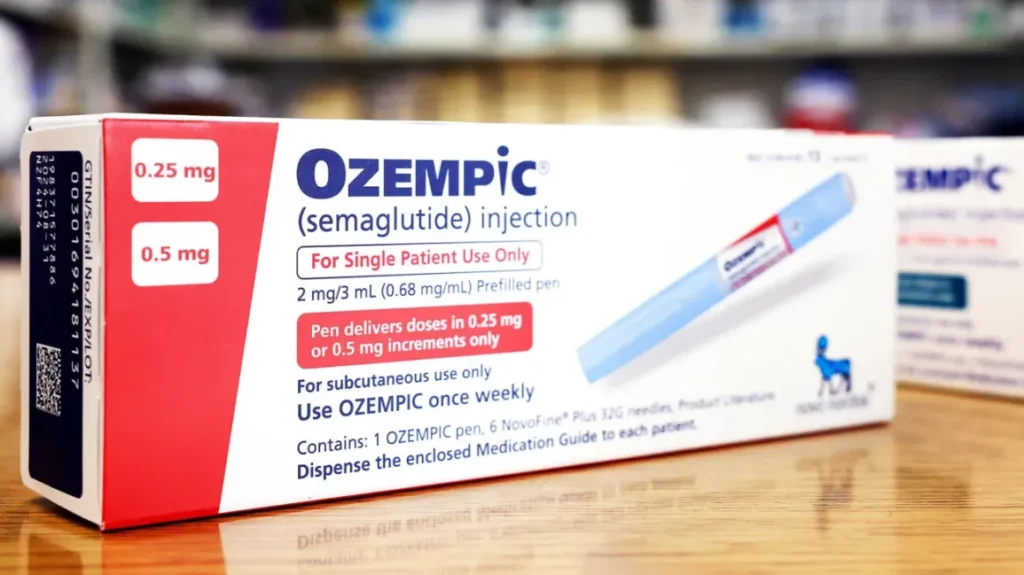Ozempic, or semaglutide, has become a very popular drug for weight loss; many use this medication for diabetes as a means to shed those unwanted pounds. Though it is not approved for weight loss, Ozempic has become notorious for its very potent side effect: extreme weight loss associated with its indication for the treatment of type 2 diabetes.
This guide covers everything you need to know, from its mechanism and side effects to the cost for weight management. While comparisons between this medication and Wegovy are common, the differences can still cause confusion. Additionally, off-prescription uses remain a separate and often controversial topic.
Understanding Ozempic
Approved by the FDA in 2017, semaglutide is a treatment for managing type 2 diabetes in adults. Let’s explore what it is, its approved uses, and how it works.

What is Ozempic?
Ozempic, generically known as semaglutide, is a medication primarily approved for managing type 2 diabetes in adults. Belonging to the class of glucagon-like peptide-1 (GLP-1) receptor agonists, it functions by mimicking the natural GLP-1 hormone, which plays a crucial role in regulating blood sugar levels and appetite.
Approved Uses
The U.S. Food and Drug Administration (FDA) approved Ozempic in 2017 for the following indications:
- Glycemic Control: Ozempic is prescribed to improve blood sugar control in adults with type 2 diabetes, complementing diet and exercise regimens.
- Cardiovascular Risk Reduction: For adults with type 2 diabetes and established heart disease, Ozempic helps reduce the risk of major adverse cardiovascular events, including heart attack, stroke, and cardiovascular-related death.
How Does Ozempic Work?
Ozempic’s therapeutic effects are achieved through several mechanisms:
- Insulin Secretion Enhancement: It stimulates the pancreas to release insulin in response to elevated blood glucose levels, aiding in lowering blood sugar.
- Glucagon Suppression: Ozempic reduces the secretion of glucagon, a hormone that increases blood sugar levels, thereby contributing to overall glucose control.
- Delayed Gastric Emptying: By slowing the rate at which food leaves the stomach, Ozempic helps prevent rapid spikes in blood glucose following meals.
- Appetite Regulation: Acting on brain regions involved in appetite control, it promotes a feeling of fullness, which can lead to reduced food intake and potential weight loss.
Weight loss is a common effect of Ozempic, but it is not FDA-approved for weight management. Consult a healthcare provider before using it for this purpose.
Dosage and Administration

Dosage Forms and Strengths
Ozempic comes as a liquid solution in prefilled single-patient-use pens. The drug is available in the following strengths:
- 2 milligrams (mg) per 1.5 milliliters (mL) of liquid solution:
◦ One pen delivers 0.25-mg or 0.5-mg doses.
◦ Another pen delivers 1-mg doses. - 4 mg/3 mL of liquid solution: One pen with this strength delivers 1-mg doses.
- 8 mg/3 mL of liquid solution: One pen with this strength delivers 2-mg doses.
Recommended Dosages
Typically, your healthcare provider will start you on a low dosage and gradually adjust it over time to find the right dose for you. The dosing schedule for Ozempic is as follows:
- You’ll start with a dosage of 0.25 mg once per week for the first 4 weeks. This initial low dose helps your body adjust to the medication.
- After 4 weeks, your healthcare provider will typically increase your dosage to 0.5 mg once per week. You’ll usually take this dosage for at least 4 weeks.
- If the 0.5-mg dosage does not adequately manage your blood sugar levels after 4 weeks, your healthcare provider may increase your dosage to 1 mg once per week or the maximum dosage of 2 mg once per week.
- If the 0.5-mg dose is effective for you, your healthcare provider will likely have you continue taking it.
The maximum recommended dosage is 2 mg once per week. Always follow your healthcare provider’s instructions on how to dose.
How to Inject Ozempic
Ozempic is administered as a subcutaneous injection (under the skin) once a week. You can inject in the following areas:
- Abdomen
- Upper thigh
- Back of the upper arm
If you also selfinject insulin for type 2 diabetes, you can inject Ozempic and insulin in the same body part but not using the exact place in that body part. Change your injection site for each dose to help reduce the chance of getting skin irritation.
It is important to inject Ozempic on the same day every week, but you may take the dose at any time of day, with or without food. Your healthcare provider should show you how to use the pen properly before you begin taking your injections.
Side Effects and Precautions

Common Side Effects
The common side effects of Ozempic include nausea, vomiting, diarrhea, abdominal pain, and constipation. Most of these gastrointestinal adverse effects are generally mild to moderate in intensity and may decrease with time as the body gets accustomed to the medication.
Serious Side Effects
While Ozempic is generally well-tolerated, it can cause some serious side effects that require medical attention. These include:
- Pancreatitis (Inflammation of the Pancreas): Stop using Ozempic and contact your healthcare provider immediately if you experience severe, persistent abdominal pain that may radiate to your back, with or without vomiting. This could be a sign of pancreatitis.
- Vision Changes: Notify your healthcare provider if you experience any changes in vision during treatment.
- Hypoglycemia (Low Blood Sugar): Using Ozempic with medications with a known history of lowering blood glucose, like sulfonylurea or insulin, together will also raise your risk for hypoglycemia. Some symptoms of low blood sugar include but are not limited to dizziness, blurred vision, anxiety, irritability, sweating, slurred speech, hunger, confusion, shakiness, weakness, headache, fast heartbeat, and feeling jittery.
- Kidney Problems (Kidney Failure): In individuals with existing kidney issues, dehydration caused by diarrhea, nausea, and vomiting may worsen kidney function. It’s crucial to stay hydrated to reduce the risk of dehydration.
- Serious Allergic Reactions: These would include an allergic reaction-where you may have symptoms like your face, lips, tongue, or throat swelling, having trouble breathing, a severe rash or itching, feeling faint or dizzy, and a racing heartbeat-so you should stop using Ozempic and seek immediate medical attention.
- Gallbladder Problems: Gallbladder problems: A number of people taking Ozempic may have gallbladder problems, including gallstones. Seek immediate medical care if you have symptoms such as: upper abdominal pain fever jaundice (yellow skin or eyes) clay-colored stools.
Boxed Warning: Thyroid Cancer Risk
The FDA has issued a boxed warning, its strongest alert, regarding a possible risk of thyroid tumors, including thyroid cancer associated with this drug. In rodents, drugs similar to it caused thyroid tumors, including MTC. It is unknown whether these events can occur in people.
It is not for patients with a family history of MTC or Multiple Endocrine Neoplasia syndrome type 2 (MEN 2). If you notice a neck lump, hoarseness, difficulty swallowing, or shortness of breath, contact your healthcare provider immediately. These may indicate thyroid cancer.
Other Warnings and Precautions
Before using Ozempic, it’s essential to inform your healthcare provider if you have or have had any medical conditions, including:
- Problems with your pancreas or kidneys
- A history of diabetic retinopathy (eye disease caused by diabetes)
Remember, while Ozempic can be an effective treatment option, it’s crucial to weigh the potential benefits against the risks and discuss any concerns with your healthcare provider.
Conclusion
The surprising weight loss potential has gained widespread attention, making it crucial to use the drug only when medically advised. While it offers benefits in managing type 2 diabetes and potentially reducing body weight, its side effects and risks must not be ignored. A thorough discussion with healthcare professionals is essential to understand all options before deciding to take it.
The decision to use this medication for weight loss should be made by a healthcare provider, considering individual circumstances and health goals. Staying informed and following professional guidance ensures a choice tailored to personal needs.
FAQ
This drug comes at a 30-day supply price of $935.77 according to the manufacturer Novo Nordisk. If you don't have health insurance coverage, this price will apply. Administered by a prefilled injection pen and used once in a week to manage blood glucose and obesity.
The price of Ozempic without insurance is about $935.77 for a month's supply of four doses given once weekly. Your final price will vary based on the extent of your insurance coverage, the pharmacy in which you have purchased it, and also on any availability of discounts or coupons for Ozempic
Common side effects that are associated with Ozempic include nausea, vomiting, and diarrhea. Although these symptoms are common, they tend to decrease after some weeks once the body gets accustomed to the medicine. Following dosing guidelines will help in managing these side effects.
On average, patients lose about 5 pounds a month on Ozempic. This estimate is based on a study where participants lost about 15 pounds over three months and about 27 pounds after six months of treatment with a weekly injection of semaglutide, the active ingredient in Ozempic.




